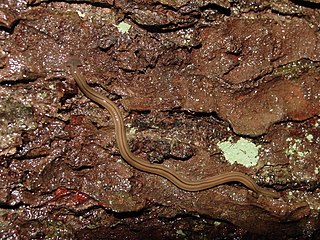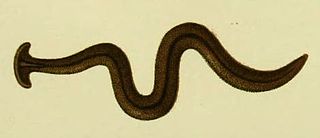
Planarians (triclads) are free-living flatworms of the class Turbellaria, order Tricladida, which includes hundreds of species, found in freshwater, marine, and terrestrial habitats. Planarians are characterized by a three-branched intestine, including a single anterior and two posterior branches. Their body is populated by adult stem cells called neoblasts, which planarians use for regenerating missing body parts. Many species are able to regenerate any missing organ, which has made planarians a popular model in research of regeneration and stem cell biology. The genome sequences of several species are available, as are tools for molecular biology analysis.

The New Zealand flatworm is a large land flatworm native to New Zealand. It can vary from 5 mm in length when hatched to approximately 17 centimetres (6.7 in) in mature adults.

Geoplanidae is a family of flatworms known commonly as land planarians or land flatworms.

Bipalium is a genus of large predatory land planarians. They are often loosely called "hammerhead worms" or "broadhead planarians" because of the distinctive shape of their head region. Land planarians are unique in that they possess a "creeping sole", a highly ciliated region on the ventral epidermis that helps them to creep over the substrate. Native to Asia, several species are invasive to the United States, Canada, and Europe. Some studies have begun the investigation of the evolutionary ecology of these invasive planarians.

Bipalium adventitium, the wandering broadhead planarian, is a land planarian in the subfamily Bipaliinae. It has been accidentally introduced in the United States, where it is considered invasive.

Dugesiidae is a family of freshwater planarians distributed worldwide. The type genus is Dugesia Girard, 1850.

Geoplaninae is a subfamily of land planarians endemic to the Neotropical region. Members of this family are sometimes referred to as the Neotropical land planarians. However, one species, Obama nungara has been introduced in Europe.

Bipaliinae is a subfamily of land planarians found mainly in Madagascar, the Indian subcontinent and Southeast Asia, although some species have been introduced worldwide.

Bipalium pennsylvanicum, the three-lined land planarian, is a species of land planarian in the subfamily Bipaliinae. They are native to Asia, but found mostly in Pennsylvania and the surrounding areas. They can reach a length of 5.1 inches or more, with a diet consisting mostly of earthworms. They reproduce sexually by creating a cocoon in the spring, but unlike related planarians, they cannot reproduce through binary fission. It is not recommended to touch these flatworms without gloves, because their mucous contains a toxin that is used for digesting prey and can cause skin irritation for some people.
Geoplana is a genus of land planarians from South America.

Diversibipalium multilineatum is a species of large predatory land flatworm.
Robert Edward Ogren was an American zoologist.
Novibipalium is a genus of land planarians of the subfamily Bipaliinae.

Humbertium is a genus of land planarians of the subfamily Bipaliinae.

Diversibipalium is a genus of land planarians of the subfamily Bipaliinae. It was erected to include species lacking sufficient morphological information to allow them to be classified in the appropriate genus.

Bipalium vagum, the wandering hammerhead worm, is a land planarian in the subfamily Bipaliinae. It has been accidentally introduced in the United States, Bermuda and various islands in the Caribbean and was recorded for the first time in Europe, in Italy, in 2021.

Bipalium nobile is a land planarian of the subfamily Bipaliinae found in Japan.

Bipalium fuscatum is a species of land planarian first described by William Stimpson in 1857. It has been found in Japan, Indonesia, and in parts of continental South Asia and East Asia such as China, India and Korea. This hammerhead flatworm may be able to survive for days in a human lung as a pseudoparasite.

Vermiviatum covidum is a species of predatory land flatworm, found in France and Italy. The Holotype specimen is MNHN JL351B.
Bipalium javanum, the Javan broadhead planarian, is a species of land planarian belonging to the subfamily Bipaliinae. It is endemic to Indonesia.













